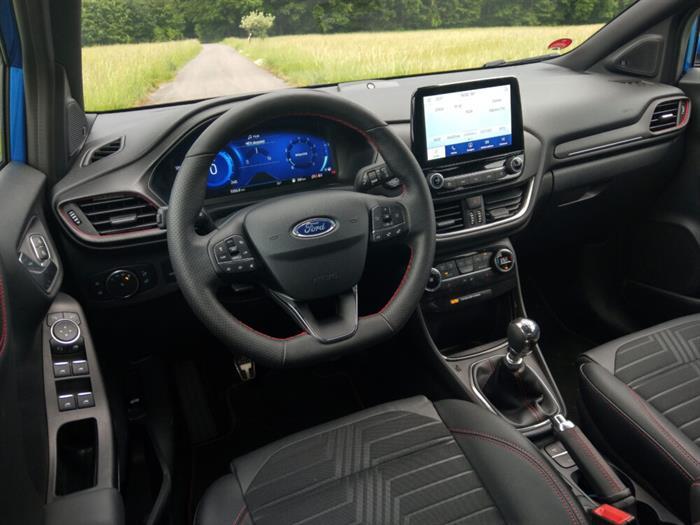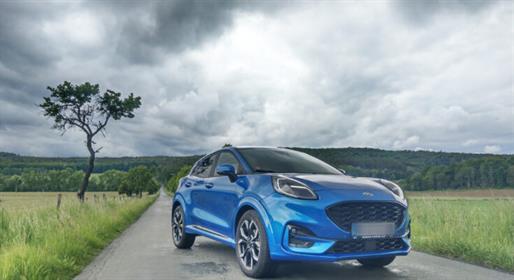Puma is back, the Ford car company has decided to revive the sports model that roamed the roads twenty years ago. However, the new, up-to-date Puma must be "trendy" and quite logically go with the times, so a small sports coupe suddenly becomes a company's favorite compact crossover.
Thus, the Puma currently passed our editorial test in the most appropriate version, i.e. in ST-Line X equipment, with a liter mild-hybrid engine and a manual six-speed gearbox.

Exterior
The new Puma, currently as a compact crossover, shares a common platform with another legend of the brand, the Fiesta model. However, its external proportions and the very handling of the car are significantly more dramatic than those of its sibling.
"To the waist", Puma offers quite robust and powerful proportions, and from the bottom edge of the side glazing, then a very low and sporty silhouette. The robustness of the lower part is thus elegantly alternated with the dynamic shaping of the glazed parts and the roof itself.
The front part bears fairly typical features of current Ford cars. The slightly "rounded" look is given to the cars by large headlights, which are significantly pushed into the upper part of the front part. Of course, there is a voluminous front mask and a dynamically shaped front bumper.
The back has similar features. The massive, side-extended, shapes of the rear bumper are then contrastingly alternated with a relatively modest rear window hidden under the rear lollipop.
I already mentioned the proportions of the side profile, which combine robustness and dynamics, above.
The new Ford Puma is quite a good car in terms of external appearance. Its sporty shapes and dynamic proportions underline its character very well.

Interior
Even in the interior, it is clearly visible that the basis for the new Puma is the Fiesta model. The dashboard itself has good workmanship and a lot of softened plastic. The fully digital instrument panel in the instrument cluster looks very good, and the graphic treatment of the infotainment display is also worthy of praise. The rather elevated proportions of the dashboard underline the announced infotainment display, which unfortunately sticks out quite a bit from the dashboard.
The entire interior, including the massive multifunction steering wheel, was then very effectively woven with a red thread, which gives the entire interior a significant touch of sportiness.
As for the internal ergonomics, here I had a slight struggle with the location of the drive mode selector, which is pretty much buried between the front seats. Furthermore, it took me quite a while to find the ideal driving position in the Puma. As a short person, I had to move my seat very close to the steering wheel to fully depress the clutch pedal. I would also appreciate it if the front seat could be moved to a lower position.
As I already mentioned, the new Puma shares the basis with the Fiesta, but exceeds it in all dimensions, including the wheelbase itself. I have already described the front seats and their problematic position finding for me, the rear bench is noticeably better, it can comfortably accommodate two adults who, thanks to the relatively subtle backrests of the front seats, have enough room for their knees and also have enough headroom .
In the interior, I would also like to highlight the B&O audio system, which played absolutely precisely.
The luggage compartment will then offer a very decent volume with an adjustable bottom height. But the main attraction of this space is the so-called Mega Box. In principle, it is a relatively large "indentation" in the trunk (its size depends on the presence of a freewheel or the location of the battery of the mild-hybrid motorization), which has rectangular dimensions, a rubberized surface and, last but not least, a plug that is located on its bottom . A purely practical matter.

Motorization – currently only with three cylinders
Puma is currently only offered on the Czech market with three-cylinder EcoBoost engines. It is a classic three-cylinder with an output of 92 kW (125 hp) and we tested a mild-hybrid that offers a very respectable 114 kW (155 hp).
Mild-hybrid technology has a classic scheme in the new Puma. The car is therefore equipped with a starter/generator, which partially functions as an electric motor and can support the three-cylinder engine with an output of 11.5 kW. This electric motor takes the necessary energy from the battery, in which it was previously stored as part of recuperation. The Puma therefore does not run purely on electricity, or it cannot be recharged. The car conserves energy through recuperation, which would otherwise remain unused. The Puma thus recovers by braking itself, or by letting off the gas and gearing up. In this case, the recuperation is very strong and the car slows down quite unusually.
The game of numbers is therefore clearly visible and in reality well recognizable, so the performance of this "athletic" drive unit is really not lacking. The doping of the motorization with electric kilowatts is clearly visible in the dynamics that this motorization demonstrates in real life.
Its brisk driving performance is then accompanied by the classic, not very popular, sound performance of a three-cylinder engine. In the case of the new Puma, this sound effect is unfortunately more pronounced than it is in the three-cylinder engines of the competition.
The indicated combined consumption of the car is 4.5 liters per 100 km. However, I didn't even come close to it for a moment, and during the weekly test it was around 6.5 liters per 100 km.
In terms of chassis, the Puma is rather stiffer, and very confident in corners. The chassis also coped very well with 18" wheels. I also have to praise the steering itself, which is direct and with a clear response. The chassis, together with the excellent steering and powerful engine, give the new Puma a distinctly sporty character.
On the side of driving assistants, the lane keeping system is definitely worth mentioning, which now dispenses with white stripes when detecting a shoulder. It is also a system that informs you of dangers in the vicinity, thanks to the car's constant connection to the Internet.

In conclusion
The new Puma can be purchased in the basic Titanium version with a basic three-cylinder engine and a six-speed manual from CZK 515,900 including VAT. The piece tested by us with the highest equipment ST-Line X, 155-horsepower mild hybrid three-cylinder and six-speed manual starts in the price list from 633,900 CZK including VAT.
The Ford Puma is a car that quite successfully put on a fashionable coat in the form of a compact crossover. Furthermore, it is also a car with a very good and sure chassis, which is supported by easy-to-read and direct steering. The three-cylinder mild-hybrid EcoBoost has enough power and the car is definitely dynamic. I see its weakness in the very core of the tested three-cylinder, which can please with its performance, but sometimes also torment with its sound.


























